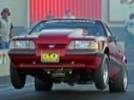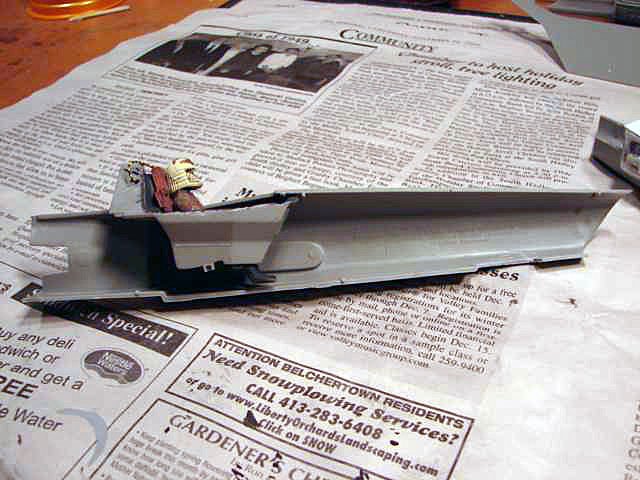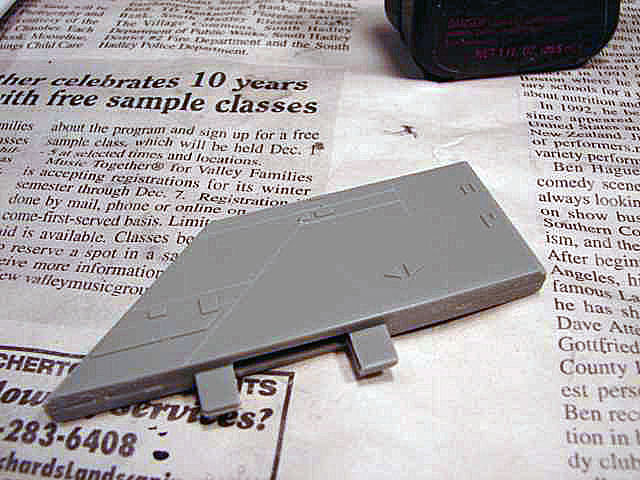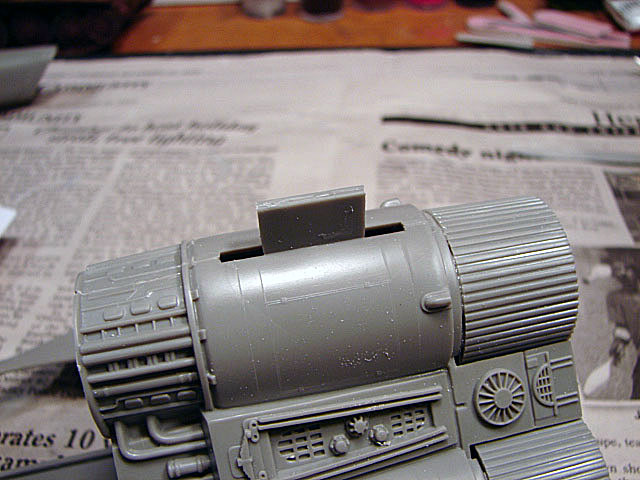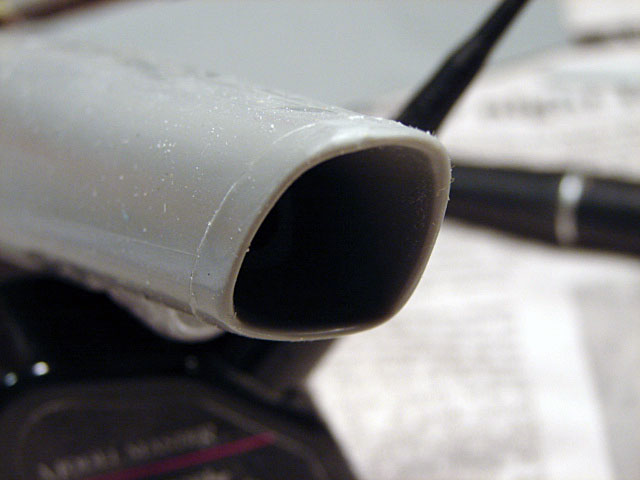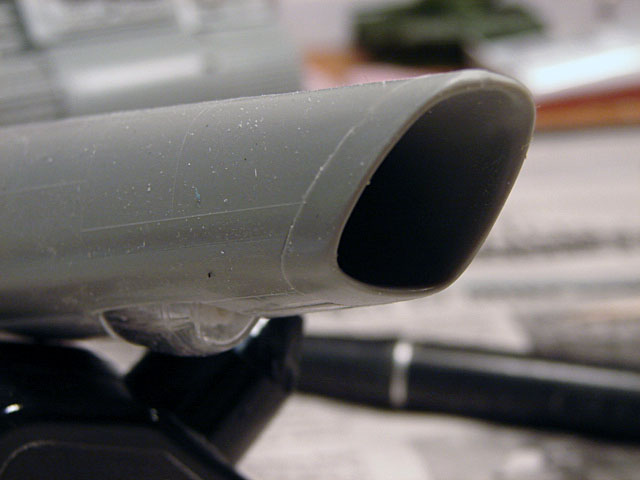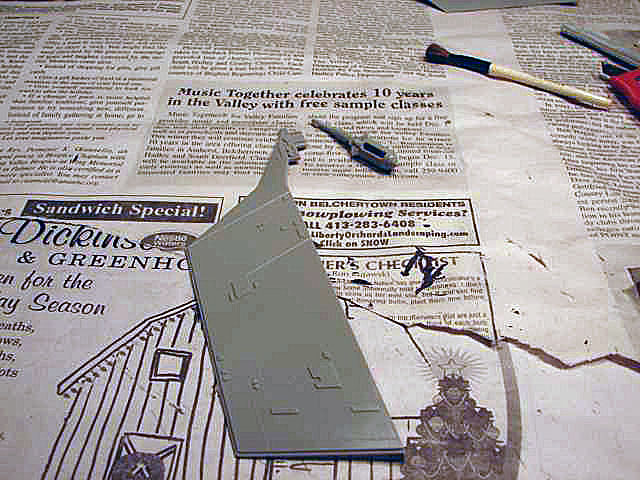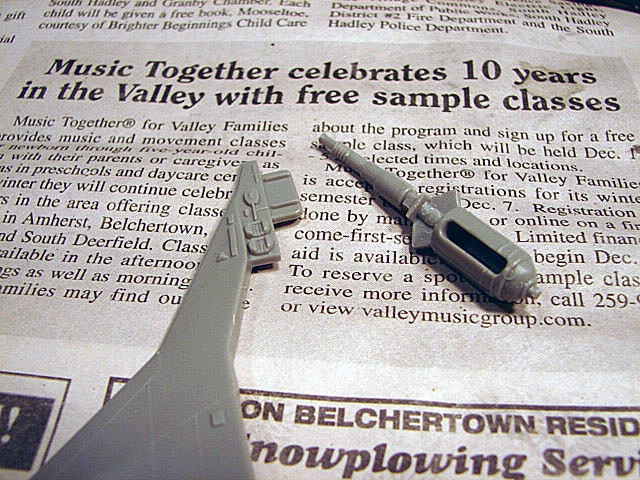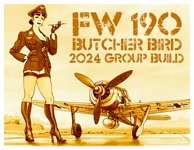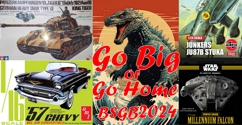Whiterook
Full Member
  
Member since: March 2013
Modeler & Wargamer
Posts: 905
Mar 13, 2013 15:29:19 GMT -5
Mar 13, 2013 15:29:19 GMT -5
|
Post by Whiterook on Mar 28, 2023 18:53:58 GMT -5
This build log is on my version of a Battlestar Galactica Colonial Viper, from Revell’s 30th Anniversary edition  However, I wanted to do something a little different to maybe spice it up a little. I decided to make it a fictionalized, Recon Viper. No, to my knowledge, there never was such a Viper, but I figured there should have been something like it theoretically. I also decided to make the outside of the original series canon, and indeed, prior to those events, but after the series, “Caprica”. The Colonial Viper is one of my all-time favorite space fighters (though, it was also capable of atmospheric flight and ground landings!), and looks absolutely plausible for flight, whether in space or over a distant alien planet. It's a sleek and sexy craft! It also screams 'fighter' to me. For this anniversary edition, it had been updated with newly tooled details, molded in light gray plastic and clear parts.....far surpassing it's predecessor of 10 years last release prior from what I've read; and this kit came with a detailed cockpit interior and pilot figure, which is an added bonus to me. When I started this kit for Build on another modeling site over ten years ago now (yikes!), I decided to go way off the beaten path and make this a Recon Viper of the Colonial Marines Fleet Patrol, complete with under fuselage camera. So basically, since I’m going with pre-Fall of the Colonies era (when the Cylons attacked the second time), this also supports the old style pilot uniform depicted on the figure. A little bit about the kit and it’s role in the Colonial FleetI found that the kit didn't have a huge amount of parts, which kinda surprised me out of the box (pun intended). I guess I was getting so used to building more complex pieces with tons of tiny little bits, that I remember that this really threw me a bit on first inspection, wondering how much of a challenge this kit would present. In the end, it actually proved to be a satisfyng build, overall. Being a Revell kit, perhaps this is more of a starter kit? But the addition of scratchbuilt extras and moving away from the kit out of box and tailoring it to a specific purpose brought the model to life for me! As mentioned, what I ended up going for was straying decades before the events in the original Battlestar Galactica series canon, and modelling after the First Cylon War; a Colonial Marines Fleet Patrol (MFP) Recon Viper, piloted by the intrepid, yet ruggedly handsome Captain Gallant ....inside joke  In my version of the Battlestar Galactica universe, the MFP was a squadron of elite fighters and served as recce deep in Cylon territory, which forced these birds to fly long sorties; fly in atmospheric low-level flight; and duck & go in asteroids and interstellar dust clouds …and well, just get the ever livin’ crap beat out of them! This means they were 'dirty birds' in more ways than one: Both in appearance, and in lethal stealth kills. These pilots were Top Guns of the Colonial Fleet....and damned good at Pyramid! This viper would be flown by the intrepid Captain Gallant, call sign “Bullet”. The bird is equipped with high tech recce photographic gear. It also has more than traditional positional thrusters in the nose and tail, for long range orbital positioning. |
|
|
|
Post by mustang1989 on Mar 28, 2023 18:58:31 GMT -5
Oh HELL yeah. I'm in!! 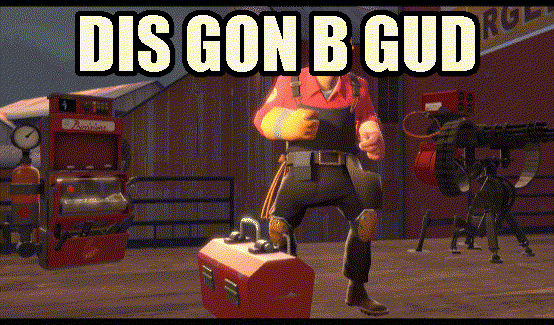 |
|
Whiterook
Full Member
  
Member since: March 2013
Modeler & Wargamer
Posts: 905
Mar 13, 2013 15:29:19 GMT -5
Mar 13, 2013 15:29:19 GMT -5
|
Post by Whiterook on Mar 28, 2023 18:58:47 GMT -5
There’s not a lot of little fiddleybits to the kit, but I did do modifications, scratchbuilding and alterations; as well as a new chipping technique (hobby knife!) and oil paint weathering to the paintjob. Some of the pics in this thread will be thumbnail size... for some reason, when I saved these pics onto a thumbdrive, it saved them as a thumbnail image, rather than full size...I have NO idea why that happens! So, first up was the cockpit tub, which though fairly true to the original series Viper, it was way too plain for my tastes so first, I airbrushed Tamiya Black Gloss on the interior. Then, I scratchbuilt arm rails. For the arm rails, I’d found the pic with the pretty pilot you see, which gave me inspiration. 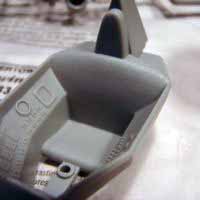    
I then scratchbuilt a seat back frame and test-fitted the pilot for fit, I test-fitted the pilot for fit, but decided the top of the seatback needed a headrest.
   I felt I was on the right track! I next added wiring/ejection seat and a scratchbuilt center control stick plate. Then it was time for interior paint.      The Draidis (Radar) console is a decal; the controls were all hand painted with a very fine artist brush. |
|
Whiterook
Full Member
  
Member since: March 2013
Modeler & Wargamer
Posts: 905
Mar 13, 2013 15:29:19 GMT -5
Mar 13, 2013 15:29:19 GMT -5
|
Post by Whiterook on Mar 28, 2023 19:03:22 GMT -5
|
|
|
|
Post by mustang1989 on Mar 28, 2023 19:06:42 GMT -5
That pit and pilot look great. Just a TON of detail in there.
|
|
Whiterook
Full Member
  
Member since: March 2013
Modeler & Wargamer
Posts: 905
Mar 13, 2013 15:29:19 GMT -5
Mar 13, 2013 15:29:19 GMT -5
|
Post by Whiterook on Mar 28, 2023 19:07:21 GMT -5
That cockpit tub was a little precarious attach, but both nose shell halves keep it propped with little pins. I was glad the figure came in original series uniform, as it fits the kits’ storyline! Finishing touches were made to the cockpit, including the “stick”, but then came my next issue… I needed to adjust the cockpit canopy, which because of the addition of a pilot’s seat, didn’t seat down (no pun intended) right, and had to be notch cut and filed in back. I also attached the ejection seat wiring to the rear of the seat.     Next up, the recce camera! I built that out of some spare parts in my bits box - where all my unused bits from different kit builds go. It was a pretty rudimentary assembly, and I decided not to go crazy painting it in the end!     I next, needed a mounting plate to go against the underside nose hull and to what the camera would rest in, within the camera canopy.    Then, I needed a box shell for the camera to be attached to the canopy plate. Using styrene, I got to choppin’ ‘n gluing. 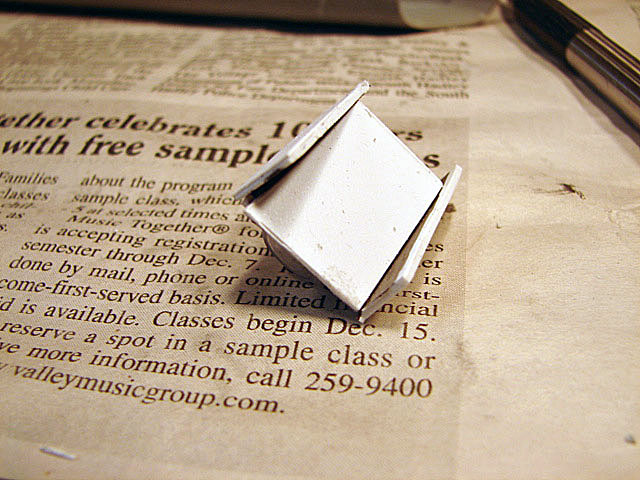 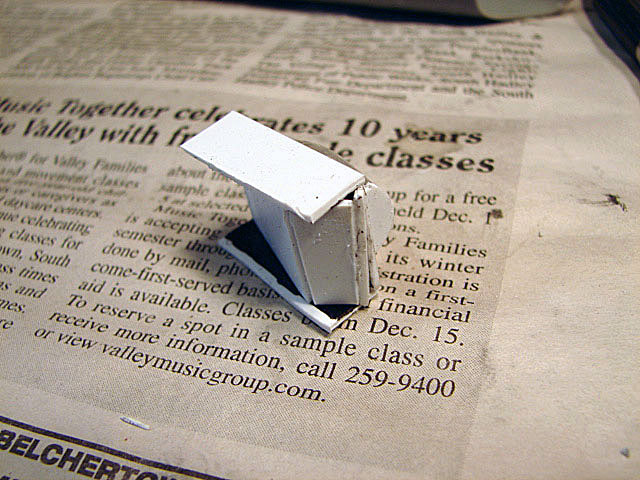 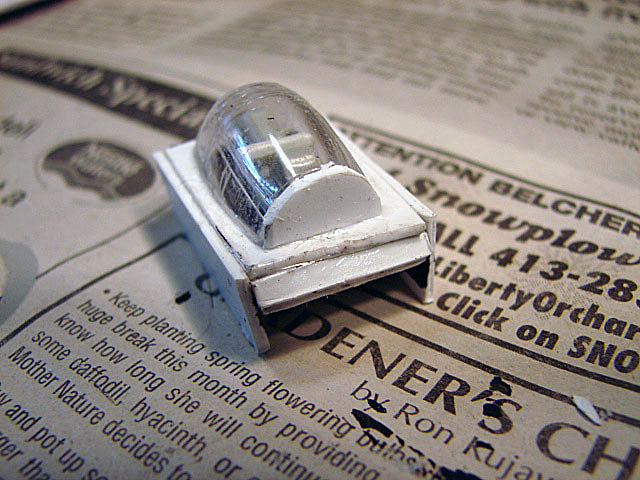 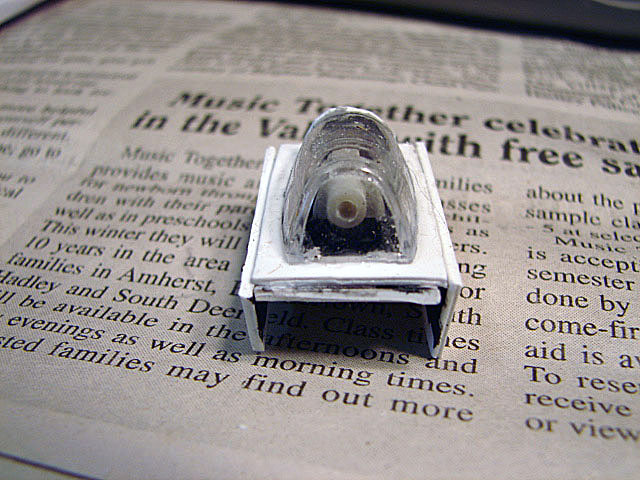 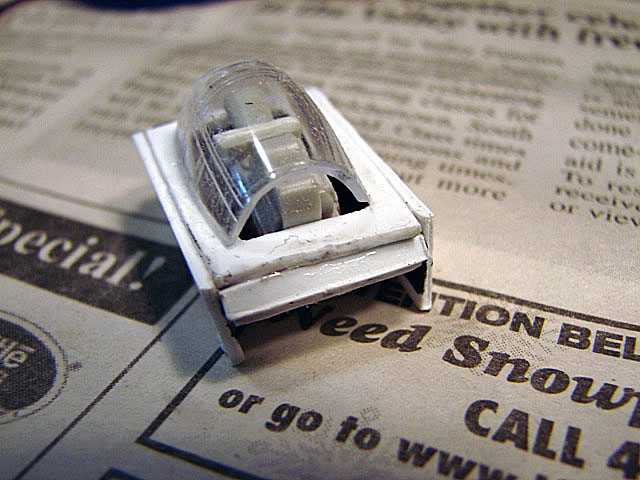 And finally, attaching the camera assembly to the underside of the. Viper’s nose! First, I taped the nose halves together temporarily and marked out the cut area using the canopy from the bits box. 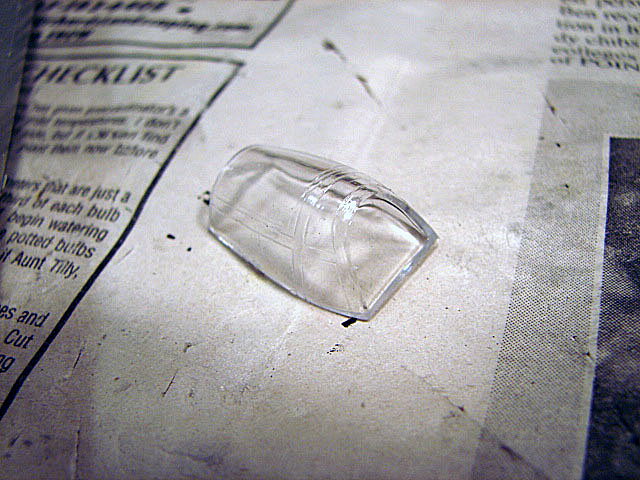 Then cut the hole through each half. Next, I attached the camera assembly to one nose hull half.    .   I glued the nose hull halves together and breathed a sigh of relief! |
|
Whiterook
Full Member
  
Member since: March 2013
Modeler & Wargamer
Posts: 905
Mar 13, 2013 15:29:19 GMT -5
Mar 13, 2013 15:29:19 GMT -5
|
Post by Whiterook on Mar 28, 2023 19:14:29 GMT -5
That pit and pilot look great. Just a TON of detail in there. Thanks! The cockpit tub was so Blah… almost 0 detail. I looked for references pics from the 1970’s show but there’s not a lot out there. I had a wonderful conversation with Richard Hatch [the original Apollo) back around 1997 and it would have been cool to ask him what he remembered of the scenes in his Viper in the series! But anyway, yeah, I wanted to get some retail in there. The Dradis (radar) was a decal, but all the dials were hand painted. I did some sculpting to add a proper pilot seat and wire to make the ejection handles… the new reimagined series has a great scene where the new Apollo gets sideswiped by a Cylon Raider and has to eject… it’s a terrifying thought to be strapped in your seat floating in space without a ship! And as for the original tub, I had a lot of latitude to add to it, as it was just a glorified bathtub to begin with! |
|
Whiterook
Full Member
  
Member since: March 2013
Modeler & Wargamer
Posts: 905
Mar 13, 2013 15:29:19 GMT -5
Mar 13, 2013 15:29:19 GMT -5
|
Post by Whiterook on Mar 28, 2023 19:17:45 GMT -5
You know, it occurs to me that I neglected to mention that with the reconnaissance camera, I pained on whether t9 paint it black or not… after the fact, I wish I had, and maybe figured out how to put a lens in it, but sometimes we just roll with where we!re at in the process and go with it. No regrets… but I think it’d have looked better.
|
|
Whiterook
Full Member
  
Member since: March 2013
Modeler & Wargamer
Posts: 905
Mar 13, 2013 15:29:19 GMT -5
Mar 13, 2013 15:29:19 GMT -5
|
Post by Whiterook on Mar 28, 2023 19:40:39 GMT -5
I always try to pick up spring clamps of different sizes and configurations when I see them in dollar stores and supermarkets! These particular ones work wonderfully for things like this!   
As you can see, the recce camera sits nicely and even looks darned aerodynamic!!! I liked the way it came out. |
|
Whiterook
Full Member
  
Member since: March 2013
Modeler & Wargamer
Posts: 905
Mar 13, 2013 15:29:19 GMT -5
Mar 13, 2013 15:29:19 GMT -5
|
Post by Whiterook on Mar 28, 2023 19:43:32 GMT -5
|
|
Whiterook
Full Member
  
Member since: March 2013
Modeler & Wargamer
Posts: 905
Mar 13, 2013 15:29:19 GMT -5
Mar 13, 2013 15:29:19 GMT -5
|
Post by Whiterook on Mar 28, 2023 19:46:31 GMT -5
|
|
Whiterook
Full Member
  
Member since: March 2013
Modeler & Wargamer
Posts: 905
Mar 13, 2013 15:29:19 GMT -5
Mar 13, 2013 15:29:19 GMT -5
|
Post by Whiterook on Mar 28, 2023 19:49:32 GMT -5
|
|
Whiterook
Full Member
  
Member since: March 2013
Modeler & Wargamer
Posts: 905
Mar 13, 2013 15:29:19 GMT -5
Mar 13, 2013 15:29:19 GMT -5
|
Post by Whiterook on Mar 28, 2023 19:52:41 GMT -5
After dryfitting the wing tops on the wing, I noticed the hole and join for the lower half of the ship and wing bottoms was visible and stuck out terribly. Bad design on this part of the kit. I added some Squadron Putty to the area, let dry, and then sanded it down. I wanted this to be finished and ready to go before I glue the wing tops on  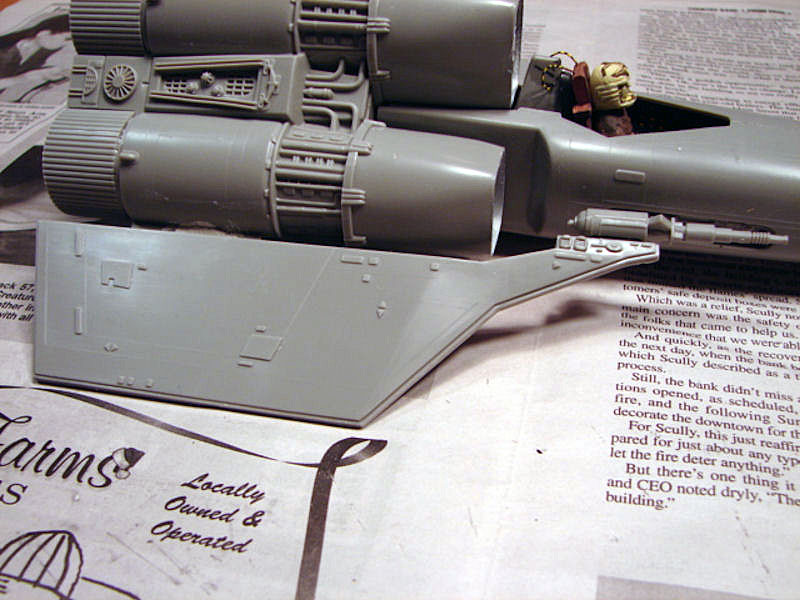 So the main assembly of the Viper was seeing all the major components of the fuselage and engines come together, which only left the cockpit canopy and the stand to assemble. I completed worked on the top half of the wings, attaching them to the lower wings; along with a little more Squadron Putty added to seal up a nasty join. The wings married up nicely, with few gaps. I needed to do a little finish sanding to smooth them off a tad. Also done was attaching the front fuselage to the rear engine/thruster section. This was a little more precarious, as the instruction gave no indication as to what adheres to what, so some eyeballing of the parts and guesstimation resulted in my slapping on some glue and hoping for the best; and luckily, I nailed it first time out! Now, it's starting to look like a Viper at that stage. 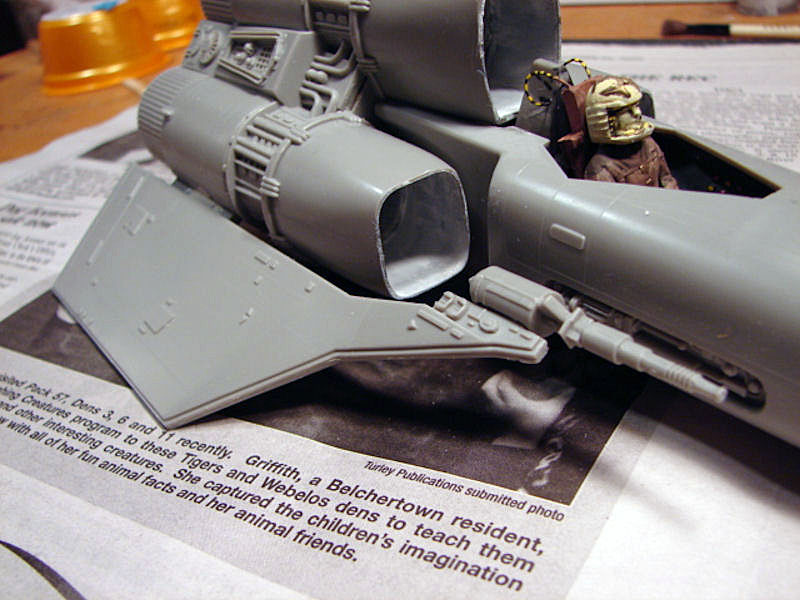 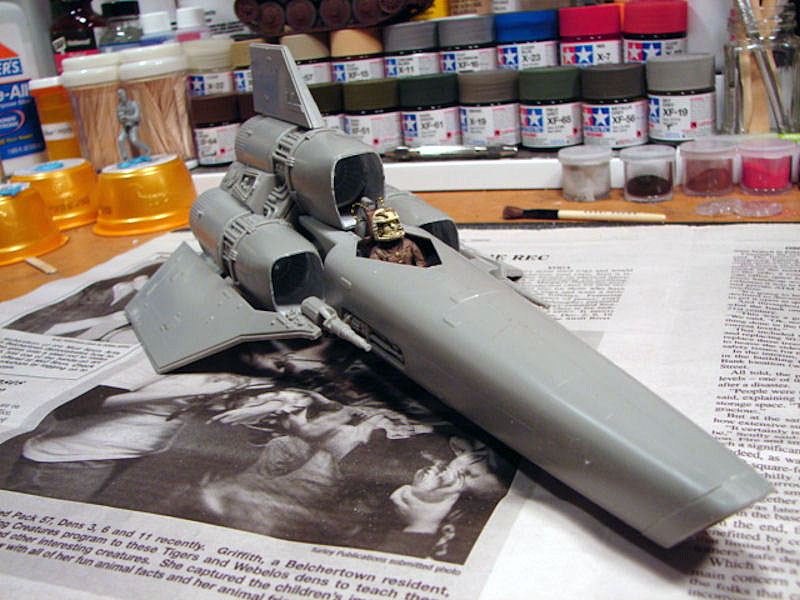 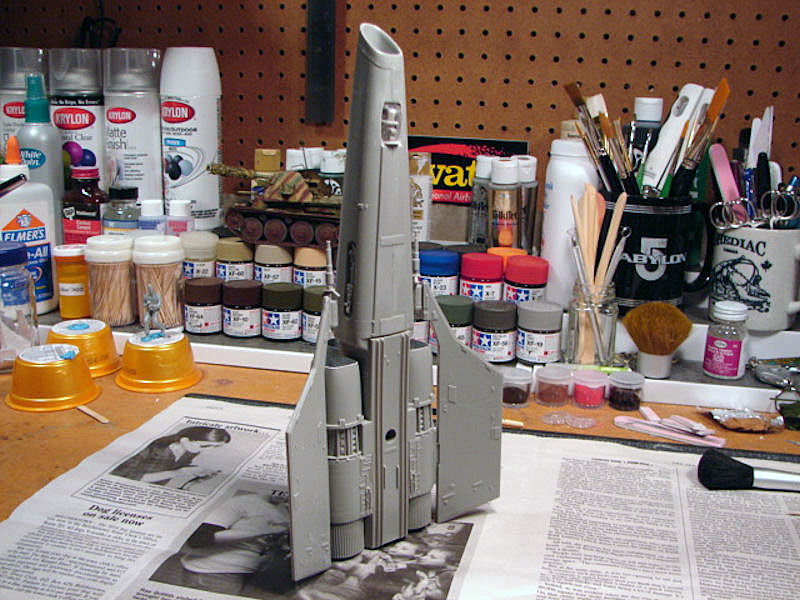 Those kinetic cannons look frakkin' AWESOME! I also really liked the way the camera bay turned out, and inspecting the craft from several angles, it looked like it was meant to be there....a good thing! |
|
Whiterook
Full Member
  
Member since: March 2013
Modeler & Wargamer
Posts: 905
Mar 13, 2013 15:29:19 GMT -5
Mar 13, 2013 15:29:19 GMT -5
|
Post by Whiterook on Mar 28, 2023 19:57:32 GMT -5
So back to the Pilot's canopy, where I mentioned earlier that there were problems with the dry-fit, and I'll go a little more into detail here: The top thruster nacelle (in back of, and above the Pilot's shoulders) was elevated above the main (long) fuselage. This caused a nasty gap between the main interior cockpit and the canopy support to the rear of the Pilot. The obvious solution was to cut down the rear of the clear plastic canopy section at the rear, which you can see here...   The ejection seat loops had to be moved forward a tad, as they became 'invisible' in the rear cockpit (or at least, they would after some paint went on the rear canopy). So to trim the back canopy down, I scored it with a craft knife, and then chipped pieces off with my sprue cutters. Worked well enough. I didn't like the look of the cockpit to upper nacelle so, I scratchbuilt a support, which I also envisioned as an avionics package housing   |
|
Whiterook
Full Member
  
Member since: March 2013
Modeler & Wargamer
Posts: 905
Mar 13, 2013 15:29:19 GMT -5
Mar 13, 2013 15:29:19 GMT -5
|
Post by Whiterook on Mar 28, 2023 20:00:32 GMT -5
I decided to paint the inner portions of the thruster nacelles, and weather. The thought process was, it's naturally easier to paint the portions now, rather than trying to angling in with a brush later. This was another reason to paint the rear half of the canopy as well, done with "FolkArt Acrylic's" White. FolkArt Acrylics is super cheap in price (as well as quality), but remains a favorite of mine for certain paint application decisions. It goes on in few applications and can be somewhat bulletproof, for areas that need to look bulletproof! It took several coats, which it typically is on this clear plastic. Later on, I would find that Future Acrylic floor polish makes this job much easier, for any acrylic paint applied to clear plastic. Then it was simply a matter of gluing the canopy to the fuselage. With the canopy lying EXACTLY on the cockpit perimeter, it was preferable to glue plastic to plastic, as the canopy will get a little paint on the 'metal' frame later, with heavy weathering. Next was cleaning up some panel lines....always fun. Actually, it is! Very Zen. Note that I usually would have used some Squadron Putty to get an ultra smooth 'seamless' look, but most of this area will either be covered with decal or heavy weathering, so all that was required was a nice smooth and even surface. Next, taping! A little Painter's tape did the trick nicely...I love my Tamiya tape, but sometimes the expensive stuff takes a side seat to the cheapo stuff (Hey, I'm from New England...Frugal, remember?),. Also applied to the cockpit canopy and the camera canopy under the nose. 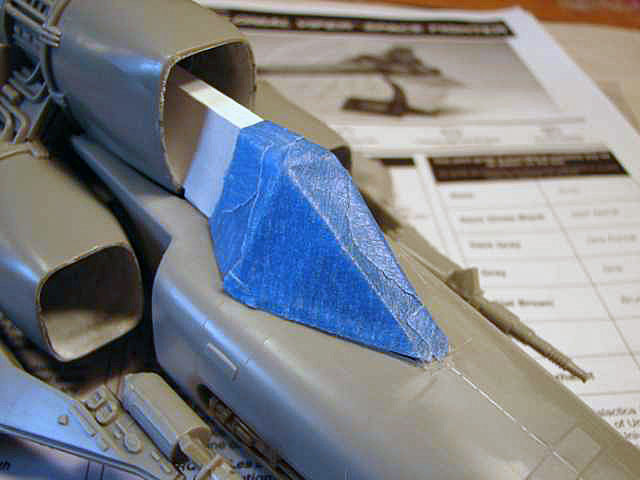 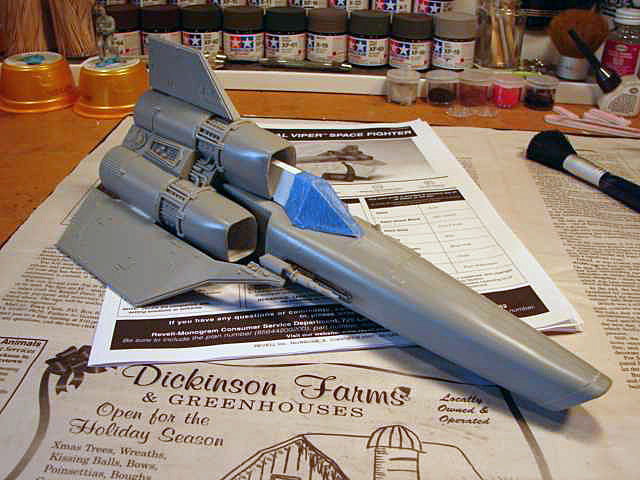 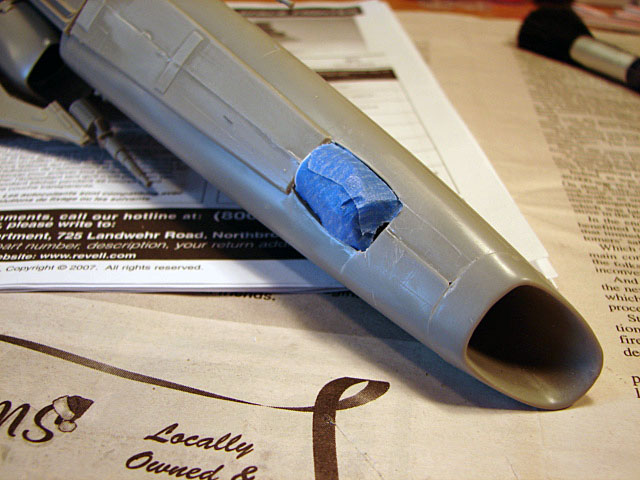 |
|
Whiterook
Full Member
  
Member since: March 2013
Modeler & Wargamer
Posts: 905
Mar 13, 2013 15:29:19 GMT -5
Mar 13, 2013 15:29:19 GMT -5
|
Post by Whiterook on Mar 28, 2023 20:06:56 GMT -5
It's Paint Time!!!I use a PACE Mini Plus airbrushing booth, found here: PACE    Initially, after having taped the clear parts, as shown above, I airbrushed the entire model with Tamiya Acrylics X-2 Gloss White. But, I was being lazy on the cockpit canopy....I knew I should have masked off the canopy so that the 'frame' was exposed, so that I could airbrush it; but again, if you didn't catch it the first time...I was being lazy, and figured I'd hand paint it. Bad idea! After thinking about it a bit, and coming to the realization that hand painting clear plastic is a pain and a half (streaky at first, and having to build up way too many layers); plus, good luck getting even edges, even with a steady Artist's hand!!! Well, I came to my senses and, I re-masked the canopy.... 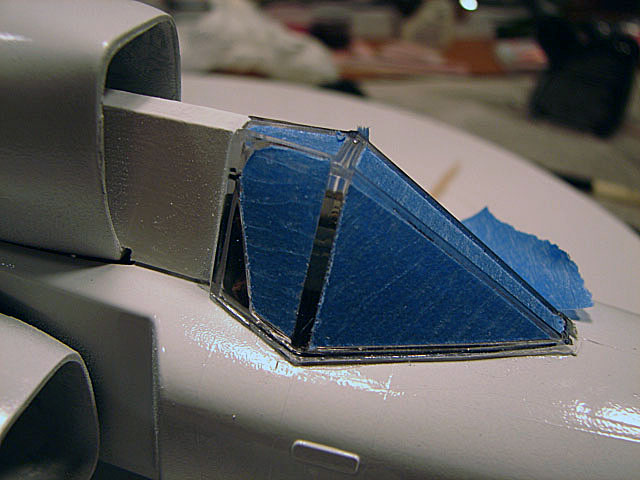  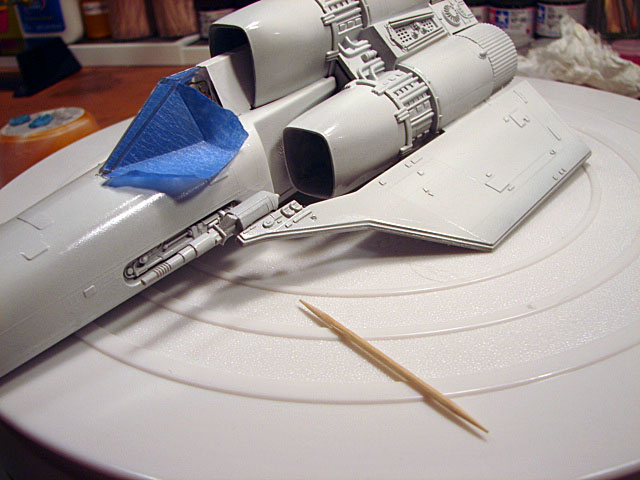 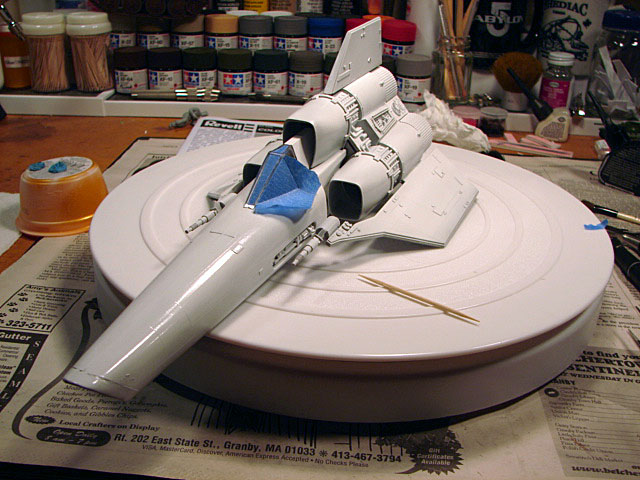 My method on that canopy was simple: Rip a small piece of Painter's tape, and lay it straight edge up just past the molded canopy frame (the model's molded canopy has a raised frame, to be painted and look like the metal frame holding the glass panels in). Then, use a set of tweezers to make sure that edge is positioned right. Next, press down against the other edges slightly with my thumb fingernail to 'find' the valley outline; and then use a toothpick to press the tape into the frame inner face, getting a good strong and clean crease. Next, using an X-Acto craft knife with fresh #11 blade, score against the raised edge several times to cut through the tape in layers. Finally, back to the tweezers, grab a corner and hold the fulcrum of the cut with the toothpick and gently peel the unusable portions of the tape off. 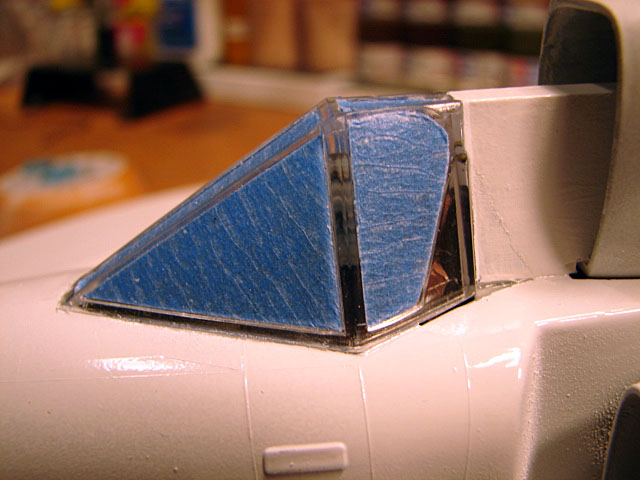  And then re-airbrushed selected areas that needed a little re-touch, and..... the canopy.  
|
|
Whiterook
Full Member
  
Member since: March 2013
Modeler & Wargamer
Posts: 905
Mar 13, 2013 15:29:19 GMT -5
Mar 13, 2013 15:29:19 GMT -5
|
Post by Whiterook on Mar 28, 2023 20:13:16 GMT -5
Now it was time for one of my favorite products ...Future Acrylic! Unlike a lot of my modeling friends, I don't airbrush it on (maybe in the future... <--- see what I did there?). I brush it straight on my kits with a 3/4 Artist Brush, and then let it sit overnight to cure. It looks like Hell at first application, but then overnight, the weight of the floor acrylic somehow breaks the tension and settles to a smooth finish. Just brilliant stuff!!! I always use this stuff for decals, and especially when I start the weathering process. I'll lay a coat of Future either just on the areas that need the decals, and when cured, lay the decals; or I'll do the whole model and lay to cure, and they lay decals ...I just follow my gut on it, dependent on the model and number of decals to go on. Thought Process: I know one of the effects I wanted on the weathering was to chip the framework of the canopy. Then, dirty the bird up; paint the thrusters and exposed wiring/pipework; chip up the 'paint' of the decal stripes; some burn marks from energy canon hits. I wanted this Viper used and abused, an on the line Bad Bird. The thrusters need some carbon marks, and the kinetic cannons need some burn marking. Of course, hydraulic oil is a must!!! And I still needed to figure out what to do with the actual engine thrusters in back, with those clear plastic inserts. BTW...at this stage, all I could think was, how much it looks like Apollo and Starbuck's original series Vipers after meeting the Beings of Light!! WHITE! Remember how, even their Frakking uniforms turned white!??! Now she looks fairly, 'factory fresh' at the moment, but that would be changing in short order, with oil washes (my first attempt at full blown oil paint washes), details, and then some chalk pastels. As mentioned previously, I am going my own way with this Colonial Viper, and Galactica purists would probably try and shoot me with a Blaster for this. Their issue...not mine. This is a Recon Viper from the Battlestar Galactica, during the First Cylon War. It's part of Colonial Marines Fleet Patrol Squadron, Viper 3, commanded by Captain Gallant. Yup, I made myself a part of Battlestar Galactica lore!!!!! This is what she looks like factory fresh after decals applied... 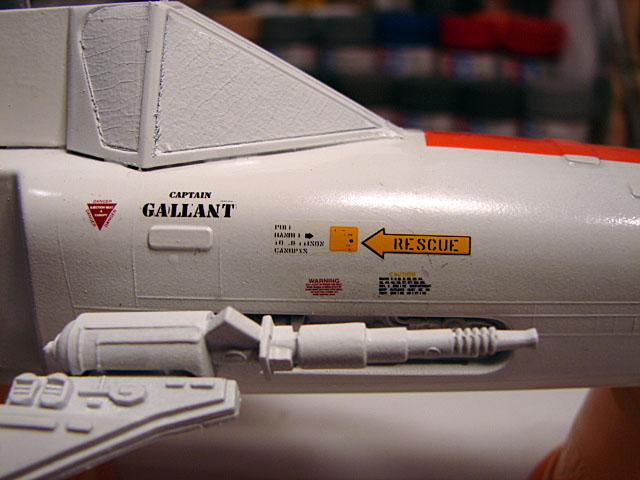  She bears the Galactica colors, and squadron/plane designation. The Pilot name and rank is below the cockpit; there's a Rescue pull handle and designation sign, along with a triangular warning sign that the Viper is ejection seat equipped, with canopy firing mechanisms....all of which that didn't come with the model kit. The main intakes have 'Danger' signs. And you can just make out caution signs above the side nose fuselage mechanics bay. The decals for the 'Captain Gallant' signs were made from the Pilot decals that came with the kit, chopped up to form my name, and the 'Captain' from Apollo's. The rest of the decals were leftovers from an RF-4B Phantom jet build. My call sign 'Bullet' is painted on the nose 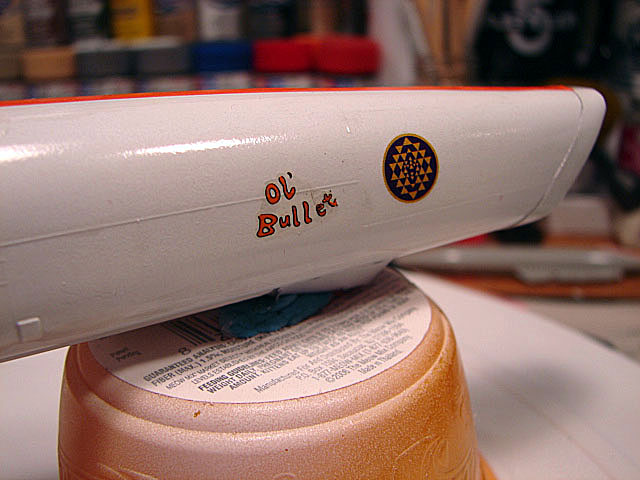 Had some silvering on the decal, but that can be taken care of mostly, in the weathering process. Next up will be the start of weathering, so hang on to your hats ...and stay tuned: Same Bat Time, Same Bat Channel!!! |
|
Whiterook
Full Member
  
Member since: March 2013
Modeler & Wargamer
Posts: 905
Mar 13, 2013 15:29:19 GMT -5
Mar 13, 2013 15:29:19 GMT -5
|
Post by Whiterook on Mar 29, 2023 9:42:29 GMT -5
I forgot to mention... I found some great 'No Step' warnings to add to the build... 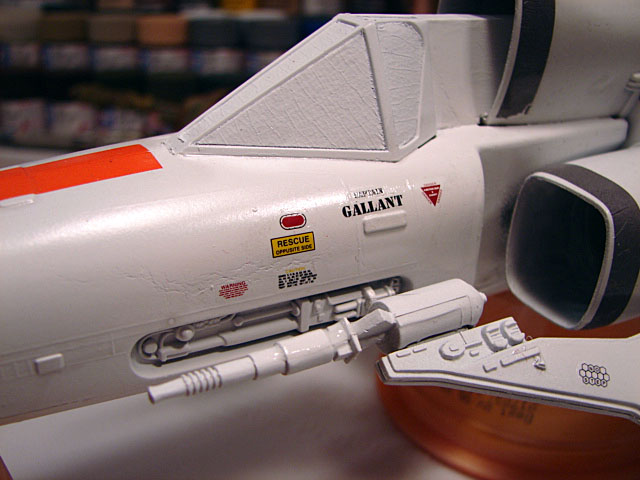 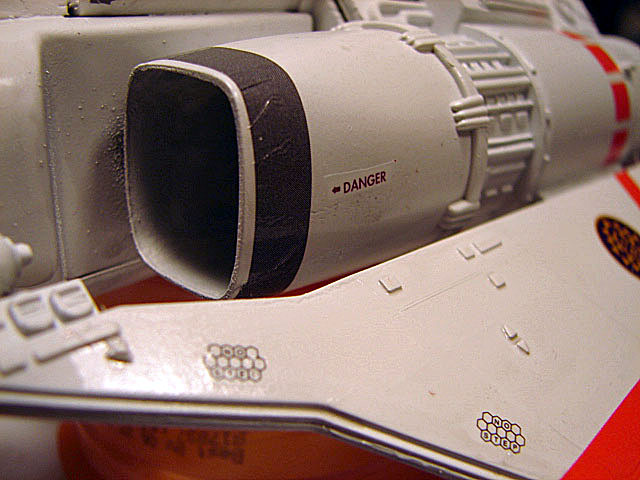 As mentioned a moment ago, weathering is the next step. All modelers face the decision: Do I want a factory fresh, without a spec of dirt look? ...or do we want that used and beaten look? On this build, the latter! |
|
Whiterook
Full Member
  
Member since: March 2013
Modeler & Wargamer
Posts: 905
Mar 13, 2013 15:29:19 GMT -5
Mar 13, 2013 15:29:19 GMT -5
|
Post by Whiterook on Mar 29, 2023 9:45:56 GMT -5
This is where a model really takes on a life of it's own, in my view....in what you can do to it to make it speak to you! I started with chipping. To recapture a thought on the direction I was heading, this is a Recon Viper, which is subject to a lot of abuse due to it's having to scoot and hide in asteroid fields, cosmic clutter filled with debris and nastiness, and also subject to many low-level atmospheric flights through all kinds of planetary weather conditions. What does all this mean? Well, it's going to get a lot bumps and bruises from rock dust and debris. Done with a #11 blade on my craft knife, it was a matter of some strategic placing where it made sense. Chipping is done with the point edge of a craft knife with #11 blade, and digging carefully at the decals; and some with the sharp-flat of the blade in a scraping motion. Both methods had the stroke of the blade head, moving in the direction that flying debris would have taken out the 'paint'. Another thing I used was a plain old sanding stick. By the way, this is why I really wasn't horribly concerned with the crummy fit of the thruster nacelle decals, all bunching up on me no matter how I positioned them; because I had planned on roughing up the leading edge anyway, so it all worked out in the end, in my opinion. As with all things weathering, the trick is knowing when to stop. This was new territory during this build, and I basically dared to fail, as the only way to excel is usually through pushing your comfort zone. I especially, like how the weathered wing edges came out.  And I love the look of the top wing, which would take quite a licking. On the Nacelles, they will get a fair bit of painting chips and grime later. 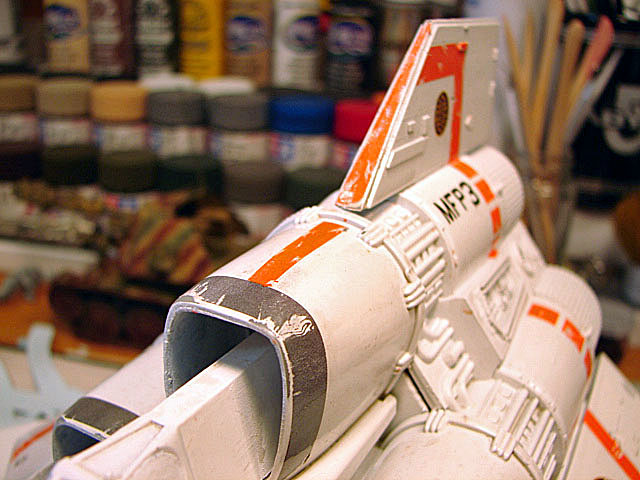  |
|
Whiterook
Full Member
  
Member since: March 2013
Modeler & Wargamer
Posts: 905
Mar 13, 2013 15:29:19 GMT -5
Mar 13, 2013 15:29:19 GMT -5
|
Post by Whiterook on Mar 29, 2023 11:48:12 GMT -5
Now, on to the scary stuff....my first oil paint and turp wash. OMG!!!!!!!! The medium of choice for this round was Windsor & Newton Turpentine with Windsor & Newton Winton black oil paint, and also mixing in some Holbein Aqua Duo burnt sienna. The Aqua Duo is a water miscible oil, meaning it thins with water, but you can use it as a traditional oil, as well. 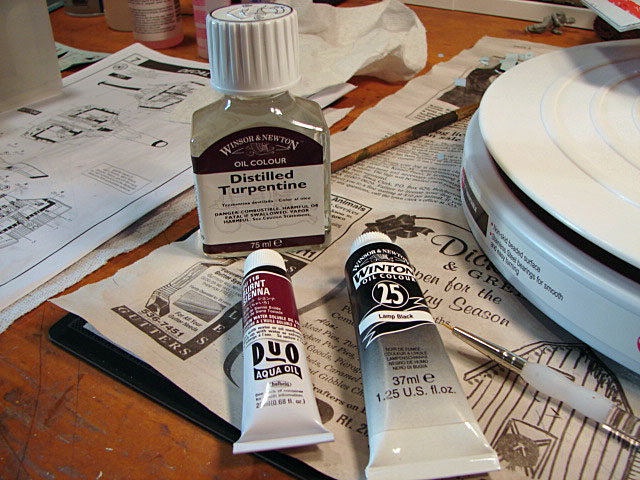 I also bought a new Royal soft-grip Golden Taklon round in 20/0 for the task... 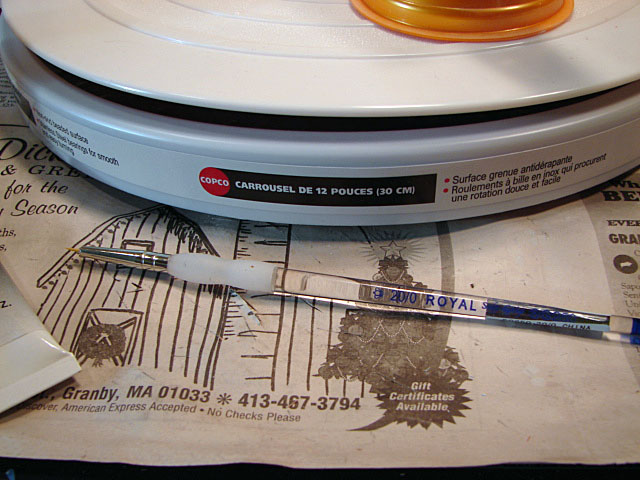 I did the standard method of placing a blob of each on a small sheet of aluminum foil, and then mixed my puddles below; grabbing the paint with the brush and letting capillary draw do its thing... 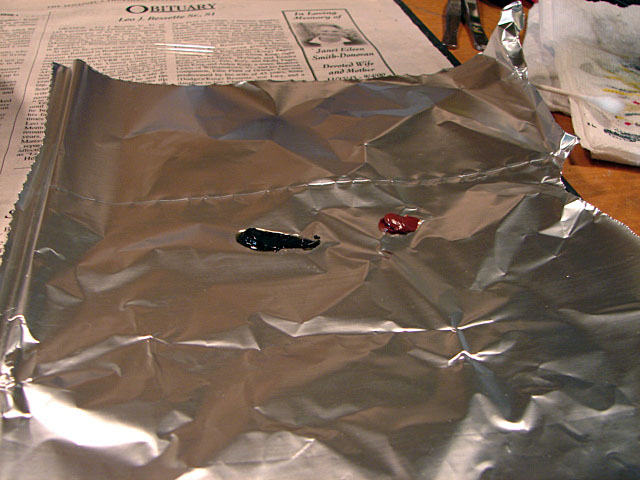 |
|
Whiterook
Full Member
  
Member since: March 2013
Modeler & Wargamer
Posts: 905
Mar 13, 2013 15:29:19 GMT -5
Mar 13, 2013 15:29:19 GMT -5
|
Post by Whiterook on Mar 29, 2023 11:54:30 GMT -5
And the results of my first ever oil and turp wash at that time. Keep in mind, this is just the start, but I gave it a good go (well, 'good' is subjective, of course! Hang on to your seats (and dinners)...   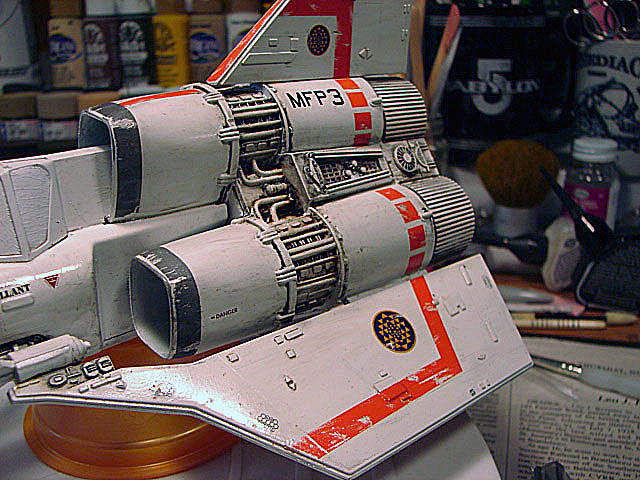 I put a small dab of the new Lamp Black Windsor & Newton paint, and a dab of the Aqua Duo burnt sienna on my palette. Then, using my brush, I made a small puddle of clear water, and grabbed some color from each dab and mixed a real wet mixture. I decided to forgo the dishsoap drop method I'd heard about, as the paint appeared to have a good enough consistency to it; and, thought it might settle in to the creases and ridges fine on it's own....which it did. I'm not saying dishsoap might mot be a bad ingredient....just not sure it's necessary. 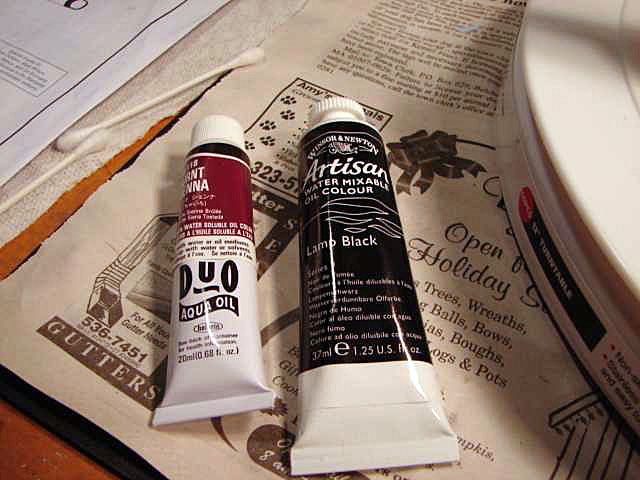  |
|
Whiterook
Full Member
  
Member since: March 2013
Modeler & Wargamer
Posts: 905
Mar 13, 2013 15:29:19 GMT -5
Mar 13, 2013 15:29:19 GMT -5
|
Post by Whiterook on Mar 29, 2023 11:57:10 GMT -5
What I really like about this method was, it seemed to have all the benefits that the oil paint and turpentine had, being sucked right into the edges and crevices it needed to go into; but none of the smell or toxicity. The drawback I noticed was, the turp cleaned up off the surface a little easier in the first method. I would dip the 20/0 brush, tip only, into the puddle and then take my time touching against edges and recesses....the extremely watered down paint mixture wicking in with capillary action to where it needed to go. The over-coverage on surfaces cleaned up fairly easily with cotton swabs and a small ball of paper towel. The cotton swab and paper towel also helped to do some staining quite nicely. I even used my rubber-gloved finger to good use in dabbing and coaxing the paint to where it needed to go. And the results! First up, the starboard side... 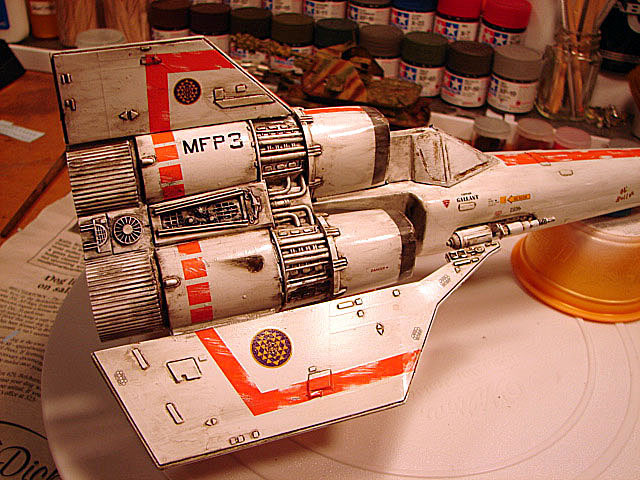 Now don't get too excited over he laser blast, as it will be fussed with a little more coming up. This was the first tome I tried this look, but it is less than stellar (pun intended). At this stage of the build, it was still a work in progress! Some of the raised edges, on the wings for example, still needed to be toned down a tad; but what I love is the dirty-muck look on the exposed engine components on the nacelles... 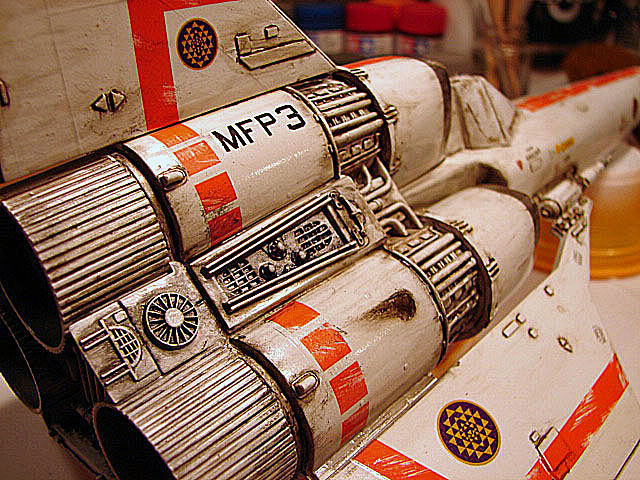 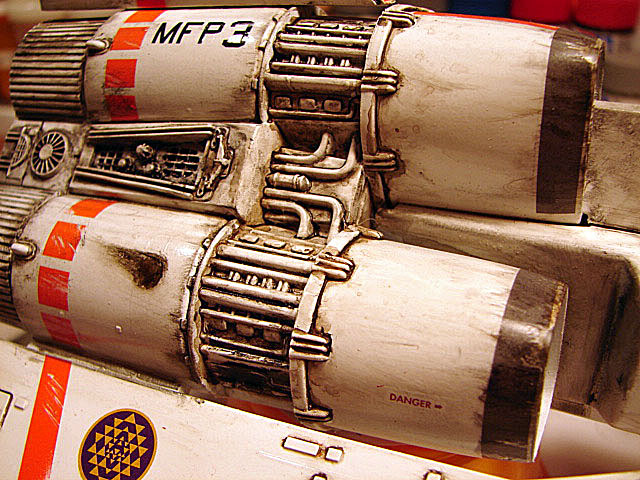 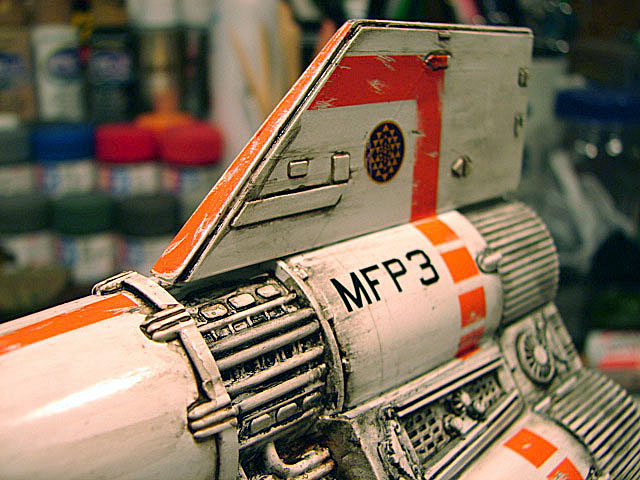  |
|
|
|
Post by mustang1989 on Mar 29, 2023 12:50:16 GMT -5
This is really some super stuff going on in this WIP. I totally missed the last few updates on this bad boy. Love what I see with all the great weathering and painting going on Emery.
|
|
|
|
Post by mrt51 on Mar 29, 2023 14:22:22 GMT -5
Oh wow! This is looking great.
|
|
|
|
Post by `Boots` on Mar 29, 2023 14:51:13 GMT -5
That looks excellent fella....some tidy work indeed, funny enough i don`t spray Future on either......i always brush it on as well.
|
|
Whiterook
Full Member
  
Member since: March 2013
Modeler & Wargamer
Posts: 905
Mar 13, 2013 15:29:19 GMT -5
Mar 13, 2013 15:29:19 GMT -5
|
Post by Whiterook on Mar 29, 2023 17:21:55 GMT -5
This is really some super stuff going on in this WIP. I totally missed the last few updates on this bad boy. Love what I see with all the great weathering and painting going on Emery. Thanks, man… o really don’t have a lot of experience with weathering yet and kinda bumble my way though it… I’ve read a lot of great build logs where some truly amazing stuff in that regard happens but, a lot of it is over my head at present (pin washes, panel lines, using specific products designed just for weathering, etc.) and overwhelming. I did pick up the Ricardi books as Christmas presents from my wife over the past few years and need to sit my butt down and read them! I understanding there are some super nice books by Mig? I’m not dissing my own self, lol… just nudging myself to elevate my learning  Oh wow! This is looking great. Thank you, my friend… I’ve been meaning to compliment you on your Avatar! I like that a Jedi is complimenting a Viper Pilot! …I mean, how cool is that! That looks excellent fella....some tidy work indeed, funny enough i don’t spray Future on either......i always brush it on as well. Thank you, my friend! Some years ago, I discovered my wife is chemical intolerant, so I went out of my way to go as non-toxic as I can with anything for her, as well as for me. I started using Future for an alter to dull coats (as part of a home brew concocted mix of 70% Future/30% Tamiya Flat Base X-21); then as a base to apply decals over to stop silvering… it’s brilliant stuff!!! Brushed on and left alone overnight, it has amazing leveling properties all on its own. |
|
Whiterook
Full Member
  
Member since: March 2013
Modeler & Wargamer
Posts: 905
Mar 13, 2013 15:29:19 GMT -5
Mar 13, 2013 15:29:19 GMT -5
|
Post by Whiterook on Mar 29, 2023 17:24:17 GMT -5
So, this seems to be the method of choice for me, discovered some time ten years ago, and still, at my current skill level. I have a chalk wash technique which would have worked well also, but in a different way. I liked where the weathering led, and it gave the appropriate look at what I had envisioned in my mind's eye for a service-heavy-use Viper that's been through a lot of extended atmospheric and asteroid debris cloud conditions, through nasty elements. But this wouldn't be where this story ended. I still had some ideas tumbling about in my noodle to make the bird a little more realistic ...retro thrusters!!! More on that in a minute! Stay tuned! A few more shots I'd taken to this point of the build... 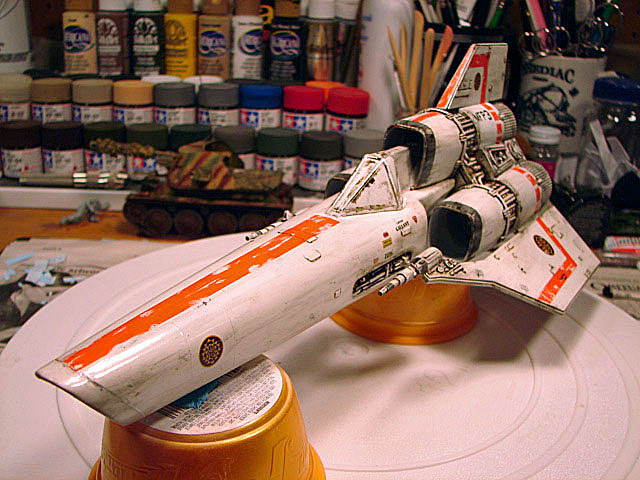 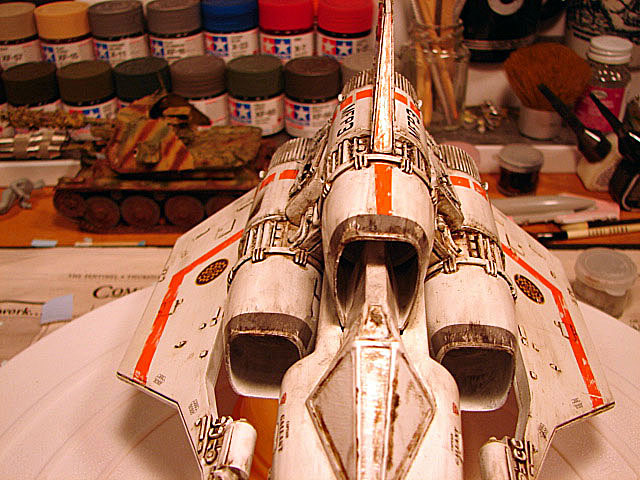 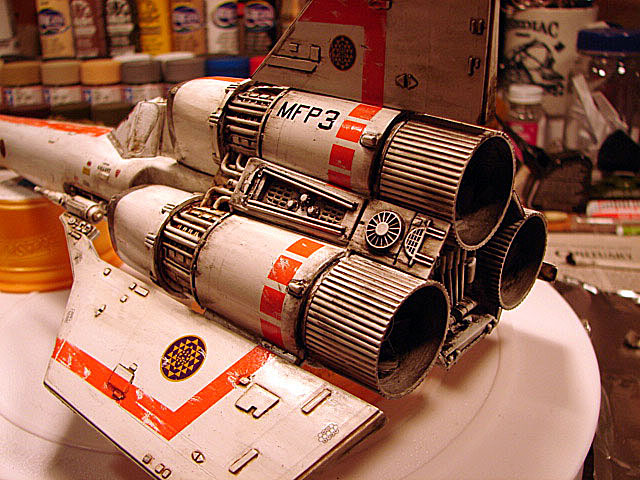 We are now nearing the end in this build. I mainly did the bottom of the Viper, weathering it much as the top. I didn't snap any pics of her belly at the time...sorry. I also touched up some of the top and sides, as well. But one of the big things I worked on was the nose. I painted the nose cone exterior a dark gray, and then a coat of lighter gray on top; followed by some chipping. Then some 'dirt' washed inside the nose cone. All done in Folk Art acrylic. Next came the fun part...out came the old pin vice and on went the Retro-thrusters! I drilled so that I broke the surface, but not drilled all the way through. Next, applying some oil paint dark brown almost to black, and then pulled for some streaking effect. 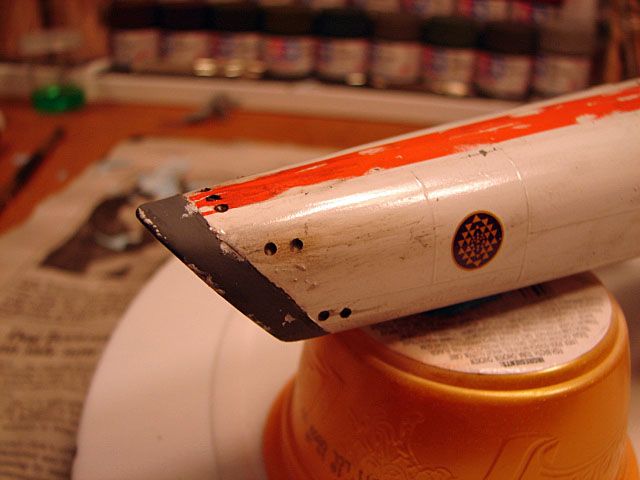 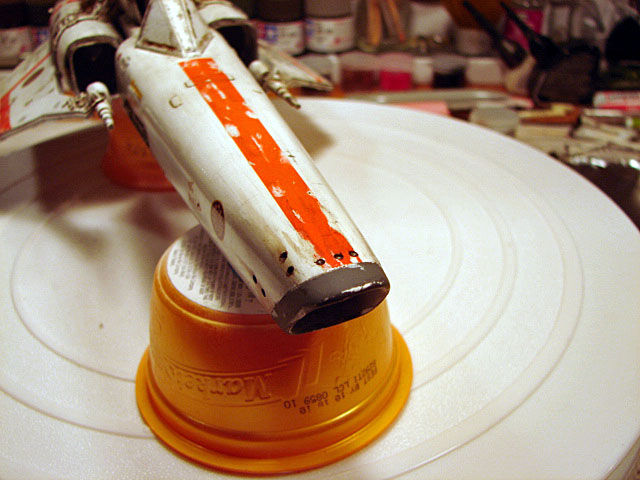 Next came the Reto-thrusters to the port and starboard engines.....and also notice the laser blast was finished up, reducing the size and enhancing the shape. 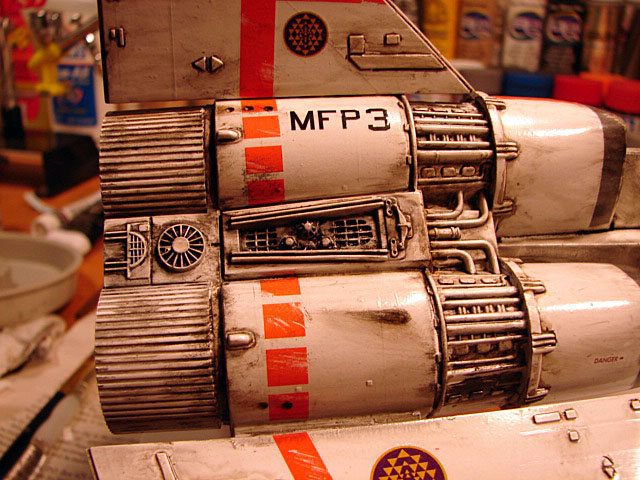 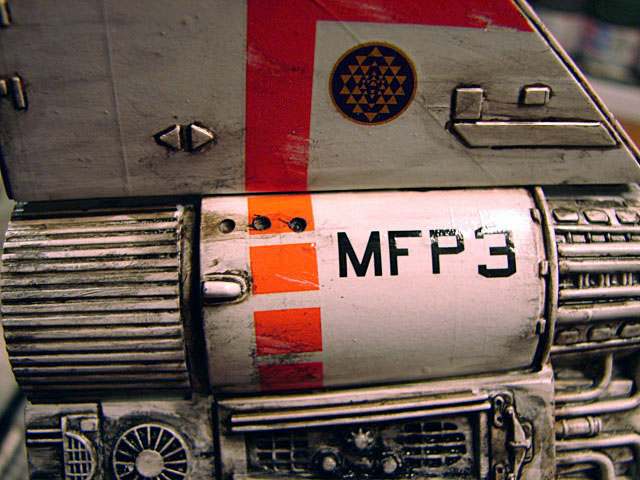 Near the bottom wing... 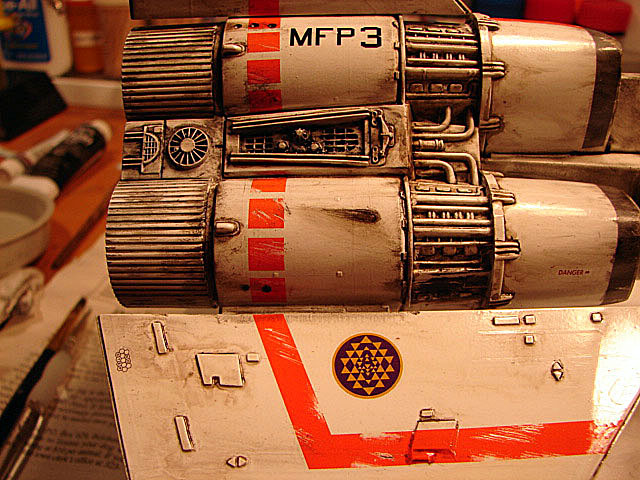 |
|
Whiterook
Full Member
  
Member since: March 2013
Modeler & Wargamer
Posts: 905
Mar 13, 2013 15:29:19 GMT -5
Mar 13, 2013 15:29:19 GMT -5
|
Post by Whiterook on Mar 29, 2023 17:27:56 GMT -5
|
|
Whiterook
Full Member
  
Member since: March 2013
Modeler & Wargamer
Posts: 905
Mar 13, 2013 15:29:19 GMT -5
Mar 13, 2013 15:29:19 GMT -5
|
Post by Whiterook on Mar 29, 2023 17:31:15 GMT -5
And finally, the point at which some of you have been waiting to see (including me at this stage!!!)....off with the canopy masks!!! But first, some reasoning behind some of the method to my madness: The early version Vipers as seen in the re-imagined series (I think these were the museum Vipers originally on display in one of the fligght pods (as part of the transition of the soon-to-be decommissioned Galactica to a museum), and particularly in "The Plan", as well as the last year of the show... these were pretty glossy; yet the original series seemed to be more satin finish looking. I chose a combination in the end. I really didn't like the look of the gloss, and especially where there is some heavy weathering on it. I sprayed a dullcoat on her....and....well....didn't like that either. So I brushed on a light gloss to areas and left others satin. I tried to go with the fact that aging would turn some areas satin, but in my view, not all. Ok, back to the build. This is the Recon Viper in all her glory, pre-Finished pictures... 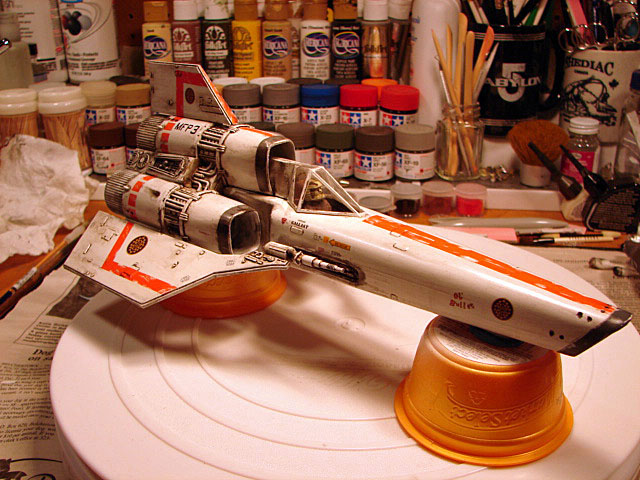 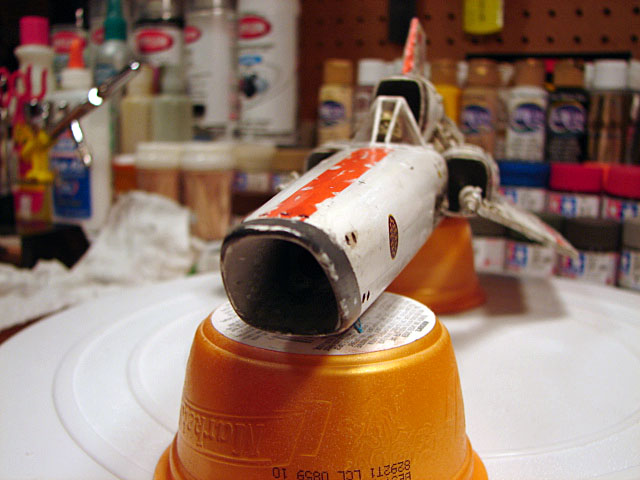 The canopy came out very good, compared to previous efforts of mine on other models. This was the first time (I believe) that I used masks so extensively and successfully. Note that I have used real airbrushing masking material (the clear stuff, and very high end), but in the end, I guess I'm just into simple methods, and the painter's tape worked a peach! And what a difference airbrushing the 'metal' fame of canopies makes!!! 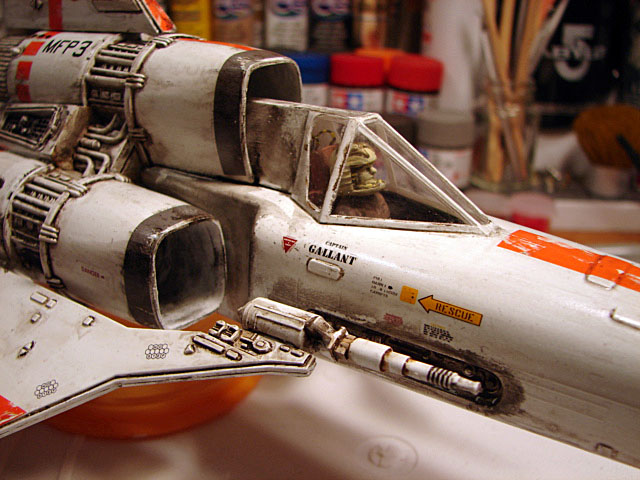 ...I tried to chip it lightly, and not go overboard. I also placed washes under the canopy to bring some depth and enhance the separation between canopy and fuselage. I also tried to indicate the chipping in the direction that space born particulate debris would have been sucked into the upper scoop; as well as the dirt and dustiness on the back canopy. 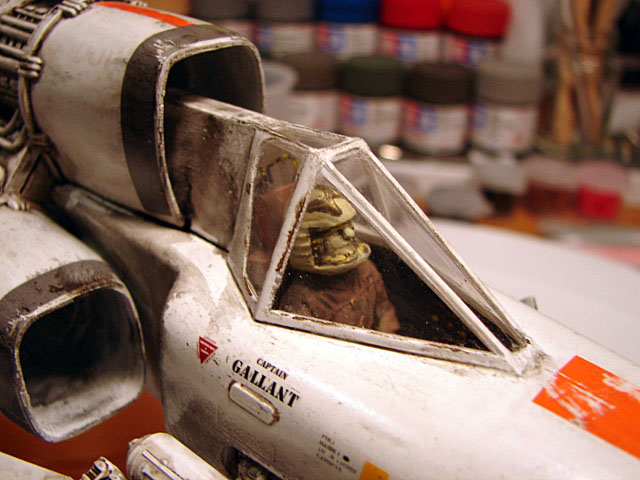 (Damn...even I have to admit that's beautiful, ROFLOL!!!!) The back edge of the fuselage would have had a bit of a dead-space whirlwind effect I believe, so I made it grimy. All in interpretation, I guess.) Personally, and all kidding aside, I really did like the way it came out. And also, it was really nice to finally see the Pilot again!     |
|
Whiterook
Full Member
  
Member since: March 2013
Modeler & Wargamer
Posts: 905
Mar 13, 2013 15:29:19 GMT -5
Mar 13, 2013 15:29:19 GMT -5
|
Post by Whiterook on Mar 29, 2023 17:45:48 GMT -5
Well folks, we're wrapping up build part of the Colonial Recon Viper! Up next was the base....and actually, it's a pretty solid base that is included with the kit. I assembled it and let set. There was nothing to really photograph in progress, as it was a pretty straightforward four pieces glued together. And of course, sanded down all the flash, mold lines and pin marks. The excitement though, was in the airbrushing! I found the magic mixture of Tamiya Acrylic to 91% Isopropyl; and decreased my psi down to 20 psi (I had the foolish thing on 40 psi!!!) ...magic! Sprayed on with control and ease not hitherto experienced, my friends ....AWESOME! Felt like I actually knew what the hell I was doing! 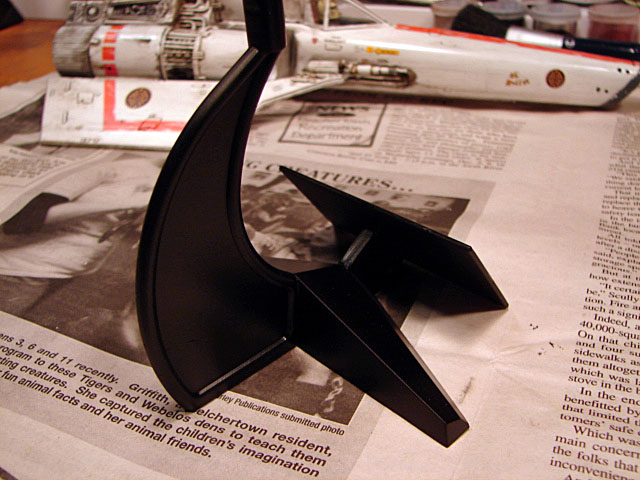 I always felt like I was rushing with the side-to-side swiping coats, and turns out it's because I was! The pressure was so frakkin' high that I had to haul a$$ or experience the dreaded runs (no, not that kind!). This was much more ease and please, so to speak. Used Tamiya Semi-gloss black. Next, some Future floor polish brushed on with a wide artist brush, on the name plate for a high gloss. 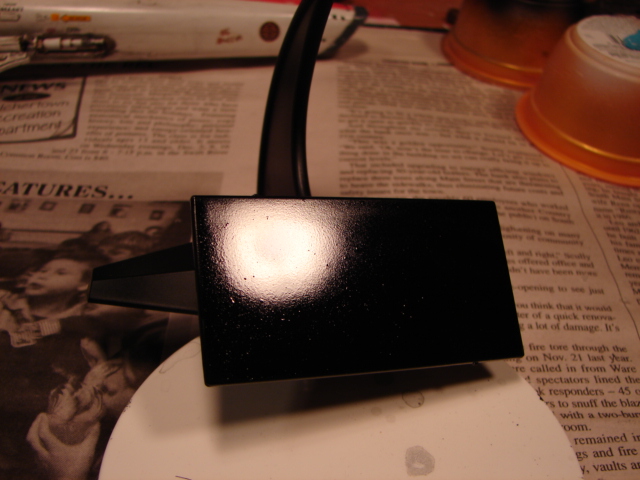 And then the decal...  And yup...my famous cat food cups ...a modeler's best friend! A final coat of Future went over the decal to seal it in and give it a good protective coat. The trick with the Future is to do only a single swipe of the art brush; two at most...and wet. Allowed to dry overnight, the Future floor acrylic coat levels all the brush lines... 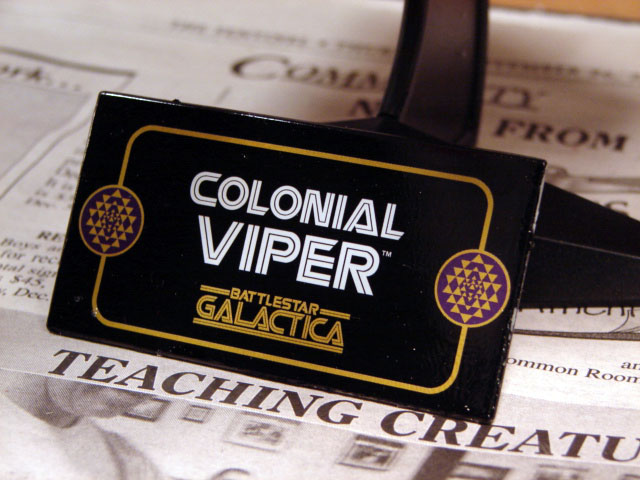 The base stand pops into the undercarriage of the Viper, and you can theoretically gimal the Viper to pose in different directions? I really don't know...it's a good friction fitting with a solid hold. 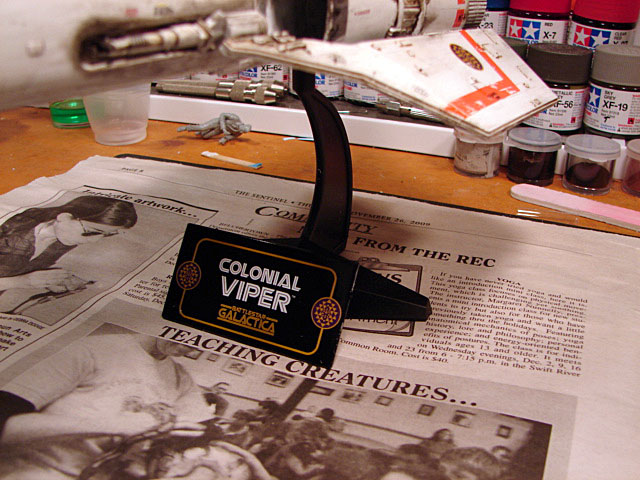  And of course, the Recon camera!   Conclusion on the building process: This was much more fun to build than I anticipated. What really got me was, the freedom to roll with it; to not be bound by trying to capture exact details, exact camo colors, etc. It could morph and become anything I wanted it to become. That energized my inspiration and turbocharged my experimentation and creativity. Everyone should step WAY out of the box every now and then; I am a firm believer in that now! I hope you enjoyed the ride as much as I did building her! And thanks for bearing with so many pics and posts in such a short time frame. |
|












